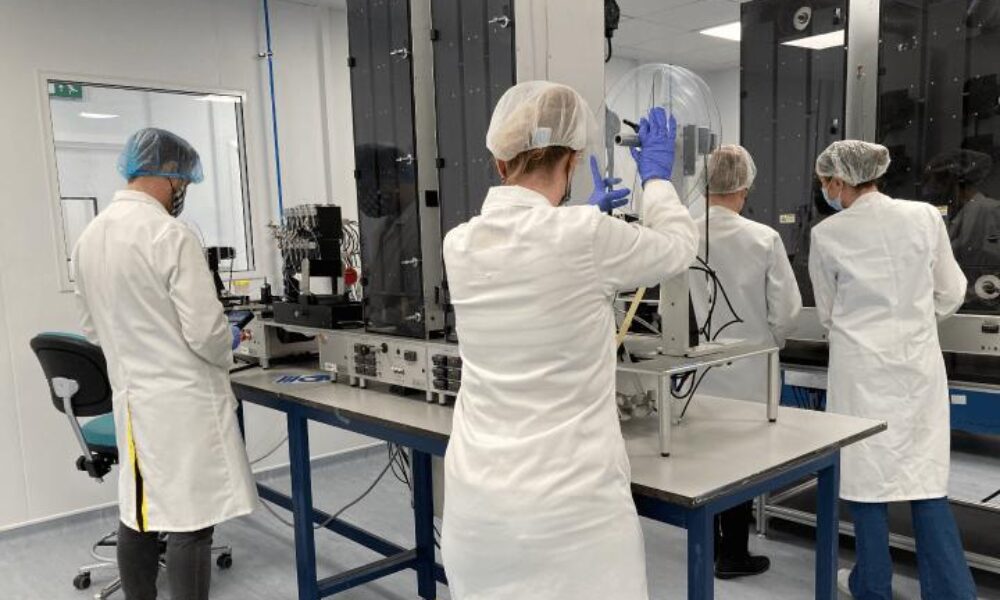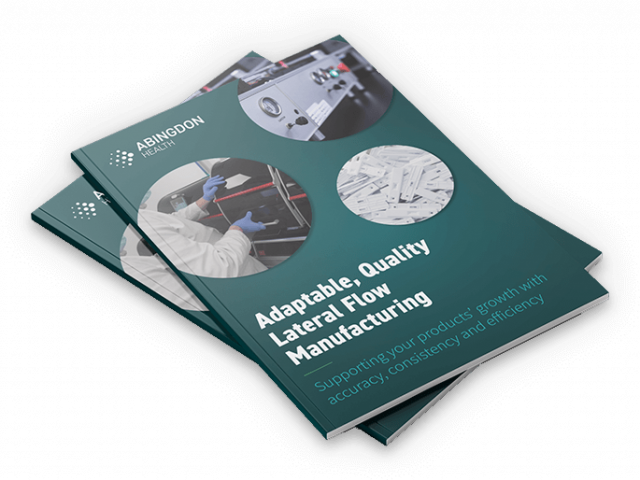Lateral flow technical transfer and scale-up: don’t underestimate the challenge

In this article, Abingdon Health’s CEO, Chris Yates, discusses investment into the development of lateral flow tests and why the early introduction of scale-up and technical transfer activities is so critical for successful routine manufacture.
The impact of COVID-19 on the lateral flow market has been dramatic and will be long-lasting for the diagnostics industry. There is no longer the need to explain what a lateral flow test is and how it works; the consumers of today and tomorrow, our children, have all undertaken numerous tests. “Doing a lateral flow test” is common parlance and highlights the fact that the barriers to adoption for lateral flow testing have been significantly reduced.
This has led to significant interest in the development of novel lateral flow tests across a broad range of indications, in human health, but also animal health, plant pathogen testing and environmental testing. ResearchandMarkets.com(1) forecast the lateral flow test market is projected to register a CAGR of 5.42% from 2021 to 2027, with a revenue of $8.5bn in 2021, and is expected to reach USD $12.2bn by 2027.
This has led to increased investment in research and development for new innovative lateral flow tests. Overall venture funding for health tech innovation was at US$14 billion, almost doubled in 2020 compared to 2019 according to Deloitte’s analysis of Rock Health database, and the growth will likely continue unabated in 2021(2) and beyond. According to Crunchbase venture capital investment into health diagnostics companies peaked in 2020 with $4.8 billion going into the sector(3). This investment in lateral flow testing is driving an increase in the volume of lateral flow developments.
My Recommendations
The development cycle for lateral flow tests varies widely according to indication and the regulatory framework, however a number of these tests are nearing the end of their development process and many of these companies are now looking to scale-up and transfer their lateral flow tests into production. This is a key area of Abingdon Health’s expertise and focus. My recommendations are as follows:
Consider scale-up from day one of your development
 It should be part of your early-stage development process. There is no point developing an innovate test if there is no way to scale up part of the process or it’s going to take a long time to do so. At the very least by considering these challenges early you can minimize delay in scale-up. Abingdon Health has an established supply chain built over decades. Tapping into this can save time and money and allow early decisions on product specification to be based on full-information.
It should be part of your early-stage development process. There is no point developing an innovate test if there is no way to scale up part of the process or it’s going to take a long time to do so. At the very least by considering these challenges early you can minimize delay in scale-up. Abingdon Health has an established supply chain built over decades. Tapping into this can save time and money and allow early decisions on product specification to be based on full-information.
Involve your preferred scale-up partner early in the process
Your partner can provide key insights into their manufacturing specification and how to tailor your product development. They can also support identifying potential supply chain partners for your key components at an early-stage and help put supply agreements in place. At Abingdon Health we are happy to have early-stage discussions to support our commercial partners well in advance of signing a technical transfer agreement. It makes the process much more streamlined if the developed test is “oven-ready” for transfer and manufacture.
Think about automation early:
 Cost is a major factor and a major advantage of lateral flow tests compared to other methods. Automation can play a major role in driving down cost and making assays more competitive. Abingdon Health has invested significantly in automating spraying, lamination, cartridge assembly and foiling of devices. This can not only improve your costings but also the potential batch sizes and manufacturing capacity. There is a lead-time to automating production if the design of the test does not meet the “standard” housing and strip widths. The more time to plan and work with the providers of automation the better solution you’re likely to end up with. Abingdon Health has established relationships with a range of automated solution providers and can support an initial conversation to determine the “art-of-the-possible”.
Cost is a major factor and a major advantage of lateral flow tests compared to other methods. Automation can play a major role in driving down cost and making assays more competitive. Abingdon Health has invested significantly in automating spraying, lamination, cartridge assembly and foiling of devices. This can not only improve your costings but also the potential batch sizes and manufacturing capacity. There is a lead-time to automating production if the design of the test does not meet the “standard” housing and strip widths. The more time to plan and work with the providers of automation the better solution you’re likely to end up with. Abingdon Health has established relationships with a range of automated solution providers and can support an initial conversation to determine the “art-of-the-possible”.
In summary, there has never been more investment going into the development of lateral flow tests. Scale-up and technical transfer is a critical element in this process and should be considered early, and on an ongoing basis. Abingdon Health can support these discussions and allow a more seamless transition from development, technical transfer, manufacturing and ultimately commercial success!
Authored by Chris Yates, CEO at Abingdon Health
References:
- https://uk.news.yahoo.com/global-lateral-flow-assay-market-154600388.html
- https://www2.deloitte.com/us/en/insights/industry/health-care/health-tech-private-equity-venture-capital.html
- https://news.crunchbase.com/news/health-diagnostic-startups-raised-4-8b-in-2020-see-new-opportunities-post-pandemic/

